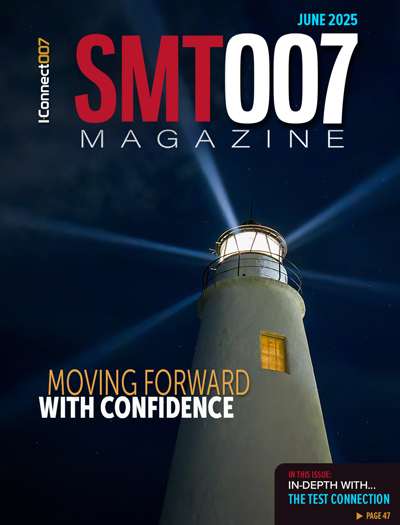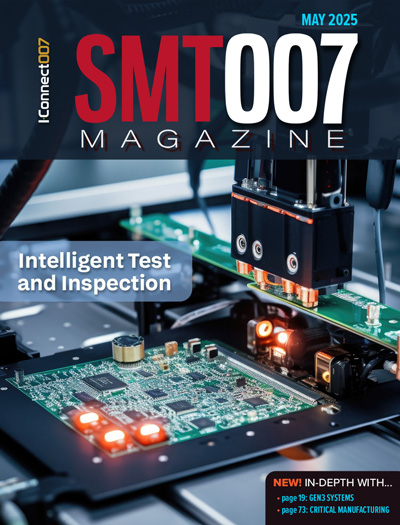-

- News
- Books
Featured Books
- smt007 Magazine
Latest Issues
Current Issue
What's Your Sweet Spot?
Are you in a niche that’s growing or shrinking? Is it time to reassess and refocus? We spotlight companies thriving by redefining or reinforcing their niche. What are their insights?

Moving Forward With Confidence
In this issue, we focus on sales and quoting, workforce training, new IPC leadership in the U.S. and Canada, the effects of tariffs, CFX standards, and much more—all designed to provide perspective as you move through the cloud bank of today's shifting economic market.

Intelligent Test and Inspection
Are you ready to explore the cutting-edge advancements shaping the electronics manufacturing industry? The May 2025 issue of SMT007 Magazine is packed with insights, innovations, and expert perspectives that you won’t want to miss.
- Articles
- Columns
- Links
- Media kit
||| MENU - smt007 Magazine
Estimated reading time: 3 minutes
Global Sourcing Spotlight: Evaluating a Supplier’s Capabilities
Global sourcing is essential for companies looking to improve cost efficiency, access innovation, and optimize supply chains. Successfully identifying and collaborating with the right suppliers on a global scale requires rigorous evaluation processes. Businesses must ensure suppliers meet industry standards, are financially stable, and can scale alongside their growth.
For years, global sourcing was all about cheap prices. Certainly, we source globally to find the best prices, but overall value is more important. The best way to find the best prices is to discover the best sources by visiting companies and developing relationships with them. Here are the best ways to provide overall value for the needed products.
Verifying Supplier Certifications
Certifications are critical to establishing a supplier’s credibility and compliance with industry regulations. Companies must verify that suppliers hold the necessary ISO certifications, such as ISO 9001 for quality management or ISO 14001 for environmental management. In specialized industries, certifications like FDA approvals, CE markings, or RoHS compliance indicate if they are adhering to global standards. Verifying these credentials through direct access to certifying bodies or independent audits helps mitigate risks associated with substandard manufacturing practices or non-compliance with safety regulations.
Onsite Visits and Factory Inspections
While certifications provide a baseline assurance, onsite visits and factory inspections offer firsthand insights into a supplier’s operations. They allow procurement teams to assess production facilities, labor conditions, equipment, and overall workflow efficiency. Conducting unannounced audits can further reveal true working conditions and adherence to ethical labor practices. Companies should consider partnering with third-party auditors to undertake detailed inspections, ensuring transparency and consistency.
Assessing Financial Stability
A financially unstable supplier can pose a significant risk to the supply chain, potentially leading to production delays or sudden business closures. Evaluating a supplier’s financial health includes reviewing audited financial statements, credit ratings, and payment histories. Additionally, understanding a supplier’s investment in technology, R&D, and infrastructure offers insights into its long-term viability. Engaging in financial due diligence helps businesses avoid potential disruptions from suppliers struggling with liquidity or debt burdens.
Technology Compatibility and Scalability
In an era driven by digital transformation, suppliers must align with their clients technologically. Companies should assess whether suppliers leverage modern manufacturing technologies, automation, and digital tracking systems. Compatibility in enterprise resource planning (ERP) systems, product lifecycle management (PLM) software, and quality control tools enhances collaboration and efficiency. Furthermore, suppliers must demonstrate scalability to accommodate growth, increased production demands, and integration with emerging technologies, such as AI, IoT, and blockchain for supply chain transparency.
Supplier Risk Mitigation Strategies
Supplier relationships come with inherent risks, ranging from geopolitical factors and trade policies to natural disasters and cyber threats. Companies must evaluate a supplier’s risk mitigation strategies, including contingency planning, diversified sourcing, and robust cybersecurity measures. Ensuring that suppliers have disaster recovery protocols, redundant production sites, and alternative logistics solutions minimize disruptions. Contractual agreements with well-defined service level agreements (SLAs) and penalties for non-compliance further strengthen supply chain resilience.
Investigating Track Record and Reputation
A supplier’s prior performance and market reputation are powerful indicators of reliability. Businesses should seek references from other clients, review case studies, and analyze customer feedback. Monitoring news reports, industry reviews, and potential legal disputes can uncover red flags that may not be evident in direct discussions. Additionally, engaging in supplier scorecard assessments that track key performance indicators (KPIs) over time can help businesses make data-driven decisions when selecting and retaining suppliers.
Ensuring Flexibility in Production Capacity
Market demands fluctuate, and businesses require suppliers that can adapt to changing production needs. It’s essential to evaluate a supplier’s ability to scale production up or down without sacrificing quality. The availability of skilled labor, raw material sourcing efficiency, and production cycle optimization help maintain flexible operations. Suppliers with multi-tier production capabilities or who implement lean manufacturing principles offer greater adaptability, helping companies navigate economic shifts and market disruptions.
Evaluating supplier capabilities globally is a multifaceted process that requires diligent research, direct assessments, and ongoing monitoring. By verifying certifications, conducting onsite inspections, assessing financial stability, ensuring technological compatibility, and implementing risk mitigation strategies, businesses can establish strong supplier relationships. Understanding a supplier’s track record and production flexibility provides an additional layer of assurance in securing a sustainable and efficient supply chain. Businesses that invest in thorough supplier evaluations gain a competitive edge, ensuring quality, reliability, and long-term success.
Bob Duke is president of the Global Sourcing Division at American Standard Circuits.
More Columns from Global Sourcing Spotlight
Global Sourcing Spotlight: Risk Management Strategies in Global SourcingGlobal Sourcing Spotlight: Tariffs—The New Reality
Global Sourcing Spotlight: Watch Out! Avoiding Pitfalls in Global Sourcing
Global Sourcing Spotlight: How Global Sourcing Drives Innovation
Global Sourcing Spotlight: Seven Key Challenges in Offshore Manufacturing
Global Sourcing Spotlight: The Surprising World of Offshore B2B Industrial Values
Global Sourcing Spotlight: Navigating the Variables of Holiday Schedules in Global Sourcing
Global Sourcing Spotlight: The Best Products to Buy Offshore Through Global Sourcing


